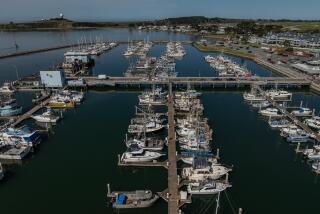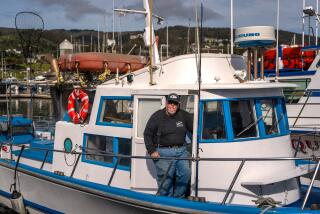Scramble Is On to Save Salmon From Oil
PORT SAN JUAN, Alaska — At last, the enormous National Guard helicopter, its invaluable cargo of oil-containing booms slung under its belly, came in low from the north.
The request for the booms had been made to Exxon two days ago. But like much that has gone wrong since the Exxon Valdez spilled more oil in U.S. waters than any other ship or rig or well, no booms appeared.
A group of state officials on the beach and fishermen in their boats on the deep green water of Sawmill Bay in the southwestern corner of Prince William Sound watched anxiously. The huge oil slick was only five miles away, ready to come ashore in a few hours if the wind picked up.
Many photogenic bays had already been abandoned to the purple-brown muck. But here on Evans Island a stand must be taken, with or without Exxon. Down the beach in a 40-by-40-foot pen, with the water of the bay flowing back and forth through the net sides, swam a million young salmon.
The fishermen financed and personally built much of the hatchery, and their livelihood has depended on it. Last season, when the pink salmon crop was endangered by failures at the other hatcheries in the sound, salmon spawned here at the Armin F. Koernig hatchery made up 90% of the catch.
So they came by boat to its defense. But until now, they had been forced to wait.
The helicopter circled reluctantly, with no obvious place to land.
“He’s worried about tearing the shingles off the roof,” of the nearby cannery, said Bob Hall, an oil-containment specialist brought in by the Alaska Department of Environmental Conservation. Hall attempted to guide the chopper in for landing in the morning chill, but the huge craft circled again then flew along the beach of Sawmill Bay, looking for a better spot.
Five minutes later it returned, dropping inch by inch, the prop roaring as it scattered debris. The hull of a 30-foot skiff lifted like a Kleenex box and slammed into a tractor. The helicopter rose again and eventually, around the corner, found a stretch of beach more to its liking.
The scramble was on to finish a series of long booms to divert, contain and if all else fails, absorb the approaching spill. By mid-morning, two long loops of yellow boom had been stretched out behind fishing boats. A pair of state troopers, running errands on their skiff, gathered bundles of the absorbent boom, which looks and feels like rolled-up toweling.
A cargo plane with no place to land dropped more bundles from Exxon out the cargo doors into the bay.
But gratitude is not on the fishermen’s minds. “Without question, this has been the most unorganized situation,” Eric Prestegard, hatchery manager, said tiredly. “I got calls two nights ago, telling me I’d have everything--and you’re just seeing it come in now.”
One small-boat owner reported that on his first run out on the sound for the Exxon containment effort his sole cargo was a crowbar. Tim Jones, a skipper who has been ferrying laborers out to the sound, said that after one run the company asked him to go out again immediately with a load of 60 sandwiches. “That’s about $100 a sandwich by what I charge,” he said incredulously.
But the effort at Port San Juan is progressing. One reason may be that, in a 3:30 a.m. meeting Tuesday with Exxon and other parties, the state of Alaska took over the effort here.
By noon, one boom is across the bay. The pipeline of supplies, now that Exxon has turned its attention this direction, is bulging. Prestegard and his troops are more hopeful.
“We’re looking pretty good. And they are starting to produce now,” he said of the central planners in Valdez.
More to Read
Sign up for Essential California
The most important California stories and recommendations in your inbox every morning.
You may occasionally receive promotional content from the Los Angeles Times.










